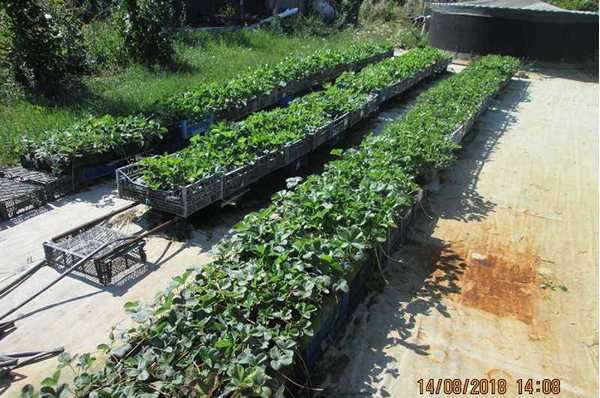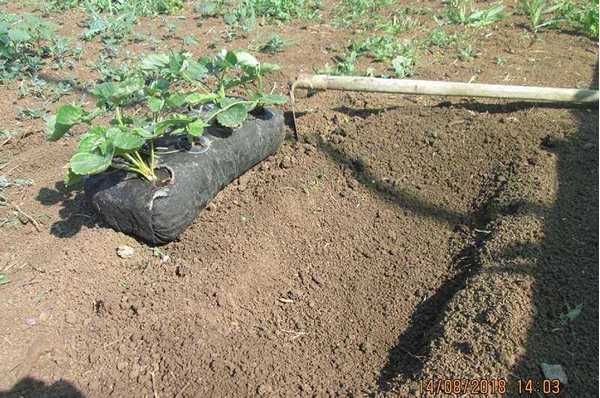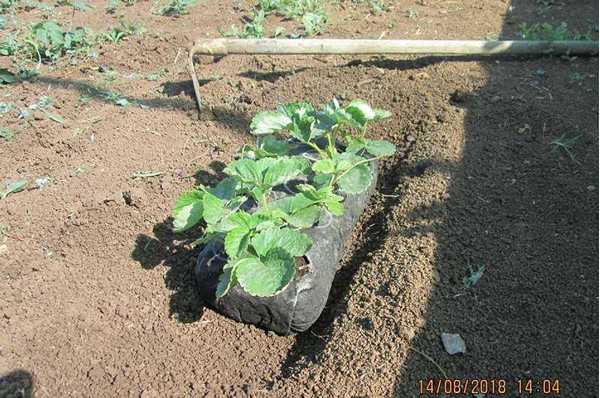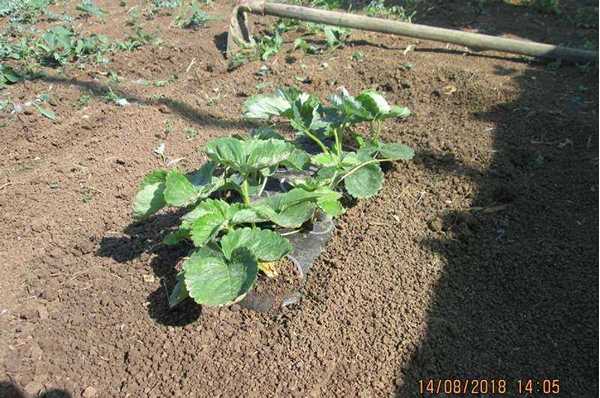Но первые мешки были сшиты не совсем правильно. Стояла задача не только найти замену горшкам, но и что бы эта замена идеально, без переделок вписалась в уже готовую линию полива. То есть, учитывая уже установленные капельницы и наконечники и их количество, а так же расстояния между ними. И что бы была полная взаимозаменяемость горшков и мешков. Те, первые пробные мешки этим требованиям не отвечали. И тогда появились мешки с размерами, которые я теперь называю стандартом «in bag». Которыми мы засадили старые гряды, в которых вырастили рассаду на следующий сезон. Они идеально подошли к нашим линиям в теплице. Которые мы уже продавали. И с которых мы собирали ягоду почти до конца октября.
Дело в том, что в плане размер мешка, точно соответствует двум квадратным горшкам. И так же соответствует по количеству кустов и расстоянию между ними. В двух горшках восемь кустов. И в одном мешке тоже восемь кустов. Длина мешка составляет тридцать восемь сантиметров. И двух горшков тоже тридцать восемь сантиметров. Ширина и мешка и горшка одинакова – восемнадцать сантиметров. Дней за пять. Не каждый день. В выборочные часы. В самый разгар сезона. Но мы сшили четыреста мешков. А чуть позже еще сотню. Потом уже, осенью, в конце сезона, мы купили рулон агроволокна и за зиму нашили почти две тысячи мешков. На будущий сезон и на последующий. Проблема эта была решена и закрыта навсегда.
Когда мы занялись изготовлением мешков и высадкой в них рассады, мы еще сами не знали, какой потенциал открывают эти мешки. Впрочем это стало ясно довольно быстро. В течении сезона. Поначалу высаживали традиционно, обычным способом. То есть брали рассаду ЗКС и высаживали в мешки. Саму рассаду тоже получали как и раньше. Укореняли под туманом, пришпиливали усы от материнского куста в стаканы, либо высаживали кассетную рассаду взятую на стороне. Клубника в мешках стала расти просто замечательно. Вскоре начала цвести и пускать усы. Среднюю линию в теплице мы полностью загрузили мешками. Остальные мешки мы стали размещать на любой поверхности, где это было возможно. На полу в теплице. Возле теплицы на земле. Но не на земле буквально. В том месте участок был накрыт агроволокном, что бы не росла трава. А сами мешки, что бы корни не прорастали сквозь агроволокно в землю, мы подняли на фруктовые ящики. Когда мешки стало уже негде размещать, мы стали их укладывать на наши наливные столы. И на старые гряды.

Технология "In bag" (В мешке)

Технология "In bag" (В мешке)

Технология "In bag" (В мешке)

Технология "In bag" (В мешке)

Технология "In bag" (В мешке)

Технология "In bag" (В мешке)

Технология "In bag" (В мешке)
И вот тут открылась новая возможность, которая и стала одной из ключевых составляющих технологии «in bag». Мы стали на грядах и на наливных столах укоренять усы не в стаканы или кассеты, а прямо в мешки. Сразу. Минуя всю эту технологическую цепочку с приобретением стаканов, набивкой их торфом, высадкой в них рассады, укоренением, проращиванием и последующей транспортировкой и пересадкой на гряды, в горшки или контейнеры. Целый технологический цикл и куча составляющих оказались совершенно не нужны. От слова совсем. Ни наливные столы. Ни туманнобразующая установка для укоренения черенков. Ни маточник как таковой. Но главное, мы сэкономили огромное количество времени. Времени, которого так не хватает в разгар ягодного сезона. Времени, которое мы теперь более эффективно можем использовать для увеличения объемов производства и качества. И все до гениальности просто.
Честно сказать, мы сами испытали приятный шок, когда пришло осознание всего этого. Это был действительно полный разрыв шаблонов и ломка стереотипов. Вся технология выращивания клубники, от укоренения усов и до сбора урожая, а так же выращивание посадочного материала, виделась совершенно по другому. Рассада «фриго»... Кассеты... Стаканы... Просто саженцы с открытой корневой... Всякие маточники, туманообразователи, наливные маты и столы для выращивания рассады... Куча статей, фото и видеоматериалов в интернете... Ничего этого больше не нужно. И не только виделась. Мы вовсю стали применять эту технологию на практике. На грядах, мы стали к центральному мешку, по бокам прикладывать точно такие же мешки и укоренять усы из центрального мешка в боковые. Без всяких промежуточных действий. В этих мешках мы получаем рассаду, которая со временем в этих же мешках, без пересадок, даст ягоду. Или так же усы. В уже другие мешки. Корневая система при таком способе, не извлекается, не травмируется и не подвергается стрессу или угнетению. Весь цикл, от укоренения и до окончания жизни растения, происходит в одном объеме.
В чем же фишка? Чем этот способ, или конкретно этот мешок лучше остальных? В чем новизна и оригинальность? И почему именно такой мешок, а не другой? А ведь действительно. Сами мешки, как емкость для выращивания придуманы не мной и вообще задолго до меня. И клубнику в них высаживают в промышленных объемах уже давно. Они были почти всегда. До появления синтетики они и были из мешковины. Потом из полиэтиленовой пленки, агроткани и спанбонда (агроволокна). Сейчас в продаже есть различной емкости горшки – мешки из агроткани. Для выращивания клубники и овощей рынок сейчас предлагает огромный ассортимент полиэтиленовых мешков и гроуматов, уже заполненных нейтральным субстратом или с удобрениями.
У любого мешка из ткани, есть одно, очень серьезное преимущество перед полиэтиленовыми мешками и обычными емкостями из пластмассы и пенопласта. Он «дышит». Есть и горшки с таким эффектом. Так называемые горшки «air pot». В них, помимо дна, на боковых стенках, проделано множество очень маленьких, с булавочный прокол, отверстий. Для чего это сделано? Дело в том, что даже относительно просторный горшок, редко удовлетворяет потребностям корневой системы в полном объеме. Особенно это касается крупных растений. Корням тесно. Во время роста, они достигают дна горшка, после чего начинают закручиваться ища выход. Растение серьезно угнетается, и в какой то момент, в конце концов погибает. Что бы этого не произошло, растение пересаживают в более просторную емкость, или в открытый грунт. В горшке «air pot» происходит следующее. Корни, ища выход из замкнутого пространства горшка, неизбежно находят эти боковые отверстия и устремляются в них. Но выйдя на поверхность горшка, кончик корешка подсыхает и его рост в этом направлении приостанавливается. Но поскольку обветрился не весь корень, а только его концевая часть, то он начинает интенсивно пускать боковые корешки от своего главного ствола. Таким образом получается очень компактная, но в тоже время вполне здоровая корневая система. Этот эффект часто используется при выращивании крупномеров. Когда в общем то довольно немаленькое растение надо поставить где то в помещении. Офисе или вестибюле. Но мешок из ткани, или дышащий горшок дает еще один очень полезный эффект. Корневая система в такой емкости реально может дышать. А это приговор грибковым болезням. То есть, что бы в таком мешке корни загнили, нужно еще очень постараться. Вот именно эти преимущества и присутствуют в нашем мешке. Он дышит, а значит ему не страшны корневые гнили. И он дает возможность получить настолько компактную корневую систему, что позволяет делать очень плотную посадку растений. Такой плотности, для которой на сегодняшний день просто не существует нормативов.
Для примера. Обычная плотность посадки в теплицах при выращивании на гидропонике составляет 10 – 12 кустов на метр. Это считается очень плотной, почти максимальной посадкой. В условиях открытого грунта, в зависимости от количества строчек на гряде, на одном погонном метре гряды может быть от 6 до 12 кустов. Причем плотность в 12 кустов на метр (иногда и более) достигается только на четырехстрочной гряде за счет ширины самой гряды. То есть использования бокового (от оси) пространства. А это занимает, в конечном итоге и большую площадь самой плантации. В технологии «in bag» на погонном метре, легко, без сильного загущения, когда оно делает сбор ягоды трудным и неудобным, и вообще без каких либо негативных последствий свободно умещаются... 22 куста земляники! То есть еще раз: 22 куста на один погонный метр. Где? Да везде. В теплице. На подвеске. Или на стойках. На дачной грядке. На грядах промышленной плантации. Это тоже одно из важных достоинств такого мешка. Он абсолютно универсален. Он применим для выращивания по любой существующей на сегодняшний день технологии. Будь это гряды, открытый грунт или защищенный. Малообъемка или традиционное выращивание. Можно просто прикопать мешок в борозду. И выращивать, как выращивали двадцать, тридцать и сорок лет назад, просто поливая из шланга. И да. Поливать его можно тоже любым известным способом. Капельной трубкой. Внешними капельницами с колышками под каждый корень. Дождеванием любой брызгалкой, голденспреем или спринклерами.
В нем можно выращивать клубнику на ягоду, использовать для маточных растений и для самой рассады. Рассады, в ее привычном понимании, тут нет совсем. Только на самом первом этапе. Когда в мешки высаживается первая обычная рассада. После этого автоматически запускается технология «in bag», которая в дальнейшем подразумевает весь цикл выращивания и размножение в таких же мешках. Вытащить и пересадить из мешка хорошо укорененный куст уже невозможно. Корни взаимно переплетаются и пытаться вытащить растение из мешка – только порвать его корни и корни соседних кустов. И да... И тоже очень важный фактор. Продается такая рассада тоже в этих мешках. Универсальное решение. Поначалу эту технологию я так и назвал. Универсальное решение. Или «Universal solution». Но это длинное и не очень удобное название. И какое то неконкретное, размытое. И тогда, по аналогии с технологией «in vitro» (дословно «в пробирке») я дал другое название. «In bag». В мешке. Это самое точное и конкретное название. Буквальное. Тут, простите за каламбур, все в мешке, из - за мешка и благодаря мешку. Вся технология, все алгоритмы действий, приемы и даже сопутствующие устройства. Например специальный дырокол. Или шпильки для укоренения усов. Все так или иначе связано или с мешком, или в самом мешке. То есть, все что не в мешке, оно даже на английском так и переведется – не в мешке. И это уже другая технология. Так что... «In bag».
Что же это за мешок такой? Ну во первых, как я уже сказал, он из агроволокна. Черного цвета. Но как показала практика, цвет значения не имеет совершенно. Поэтому можно и из белого, или вообще любого. Мешок вообще может быть из любой ткани, лишь бы она пропускала воздух и воду. Поэтому пленка для этой цели не годится. Но ничем не хуже будет мешок, например... из мелкоячеистой, (типа москитной) сетки. Другое дело стоимость и техпроцесс таких вариантов, но свои функции мешок из сетки будет выполнять не хуже.
Далее. Его размер. Почему размер именно такой, а не другой? Так ли это важно? Конечно, земляника будет прекрасно расти и чувствовать себя в мешках любого размера. Но когда мы разрабатывали мешок, мы делали его не только под себя. Нам хотелось, что бы вся эта технология, то есть совокупность и последовательность действий, и вещественные составляющие, были интересны и востребованы другими ягодниками. Мешок должен быть удобен в работе. В буквальном смысле. Их во время производства работ, приходится переносить с места на место. В теплицу или на гряды. В машину или из машины. На зимовку или весной для извлечения из места зимовки. Кроме того, он должен быть максимально унифицирован. И подходить как для гидропоники в теплице, так и для гряд промышленной плантации. Так же быть единым как для взрослого растения, так и для только что укореняемого усика. Наш опыт работы с мешками показал, что всему этому соответствует мешок, длина которого не превышает сорок сантиметров, а ширина (диаметр) около восемнадцати. «Около», потому что величины эти относительные. Агроволокно имеет свойство растягиваться. Кроме того, когда мешок лежит на плоской поверхности, его низ так же принимает плоскую форму, а его сечение ближе к приплюснутому овалу, чем к окружности. Мы сначала пробовали работать с мешками длиной полметра. Психологически этот размер как бы более приемлем и понятен. Но такой мешок, если он увлажнен, приходится придерживать двумя руками. В противном случае, в середине он перегибается. При этом могут травмироваться корни, особенно молодых саженцев. При длине мешка в сорок сантиметров, его легко можно удерживать одной рукой. И уж тем более, когда хорошо развитые корни, переплетаясь, связывают его как арматура. Взяв такой мешок в одну руку, вы свободно, без усилий, держите в руках восемь растений. Восемь! И вы можете взять в другую руку еще один такой мешок. И держать или переносить шестнадцать кустов. Много это или мало? Посмотрите на традиционные горшки, различные ящики и контейнеры, которыми вы пользуетесь. И прикиньте, сколько кустов клубники вы сможете взять, и перенести за один раз. И сколько это будет весить. Есть еще один, пожалуй, самый главный аргумент в пользу такой длины мешка. Все мешки, выпускаемые сегодня нашими(?) и зарубежными производителями, предполагают их статичное состояние. То есть до того момента, пока в мешок не высажена клубника, его конечно можно транспортировать, переносить с места на место, складировать штабелями и прочее. Но как только в него высажена клубника, все. Мешок должен быть на линии, столе или гряде, то есть на постоянном неподвижном месте. Он просто не рассчитан на переноску и транспортировку с саженцами. Это достаточно тяжело, неудобно и может повредить не только корни, но и сами растения.
Так вот мешок «In bag» как раз и задуман с таким прицелом. Его можно переносить, брать в каждую руку по мешку. Складывать на тележку, в машину, на линию или в обратном направлении с саженцами клубники любого возраста! Конечно не друг на друга. Для этого должна быть специальная тара, позволяющая многоярусную укладку. Но транспортировка, переноска и перевозка допускаются. Для чего это сделано? Опытные ягодники знают, что рассада ЗКС предпочтительней открытой корневой системы. Считается (и обоснованно) что она лучше. Но дело в том, что в рассаде с закрытой корневой системой, очень трудно вырастить мощные корни. С толстой, не менее двадцати миллиметров, корневой шейкой и тремя-четырьмя рожками. А вот рассаду "фриго" с корневой, больше двадцати миллиметров, увидеть вполне можно. В маленьком объеме (стакане или кассете) получить такой результат невозможно. Значит приходится, либо впоследствии пересаживать такую рассаду в большую емкость, либо сразу укоренять усы в большом объеме. Только потом все равно извлекать на ПМЖ. И тот и другой варианты очень, либо неудобны, либо трудоемки. А в первом случае, и растениям никакой пользы от периодических пересадок. Кроме того, рассада в маленьком стакане или горшке гораздо хуже переносит зимовку, потому что в пластиковой емкости гораздо выше риск обезвоживания корней и их последующей гибели. Именно поэтому хорошую, качественную рассаду ЗКС, очень редко можно увидеть весной.
В мешке ничего этого делать не нужно. Его объема даже для восьми кустов вполне достаточно, что бы каждый куст прекрасно развивался и образовал мощную корневую систему. И он неизвлекаем. Совсем. На протяжении всей жизни. И транспортировать его можно практически на любом возрастном этапе. То есть это задумано, если мешки рассматривать и эксплуатировать как рассаду с закрытой корневой системой. Да и какой либо другой рассады, в этой технологии просто нет. Есть рассада в мешках. Которая продается и покупается, перевозится с место на место, грузится и выгружается. Рассада в мешке «In bag» прекрасно зимует, и может быть предложена к продаже ранней весной. С мощнейшей корневой системой и несколькими рожками, готовая сразу «выстрелить» большим количеством ягоды. Очень серьезный конкурент рассаде «фриго» самого высокого качества. Конкурент, которого раньше у «фриго» не было. Объем мешка стандарта «In bag» не более семи литров. При этом на один куст условно приходится чуть менее литра объема. Условно, потому что корни отдельно взятого куста не ограничены литровым объемом, а со временем занимают весь объем мешка. Весит такой мешок, напитанный водой и с высаженными растениями, не более пяти килограммов. Для примера и сравнения, это вес силикатного кирпича. Мешок стандарта «In bag», как уже было сказано, унифицирован и един для всех целей и способов выращивания. Он подходит для большинства стандартных тепличных линий. Его можно расположить на столах или на грядах. В нем прекрасно укоренять усы и выращивать рассаду. Без всяких последующих извлечений рассады и пересадок в другой объем. А значит без стресса и травмирования. В нем достаточный объем субстрата для восьми кустов клубники, и в тоже время он достаточно легкий. Кусты в мешке расположены в два ряда по четыре штуки. Это не только требования компактного и максимально плотного размещения. В случае, если у вас мешки поливаются капельной лентой, она очень органично размещается между кустами. И этими же кустами фиксируется от сползания в сторону.
Читайте продолжение: Глава четвертая